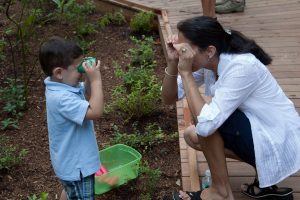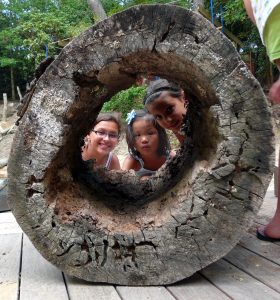Seeing is Believing: No Teacher Left Indoors (Part 3)

© Lance Keimig Photographics
Those of us who have inhaled the Nature Explore Classroom experience truly “get” something that many others simply haven’t seen or experienced firsthand; rich, whole-child learning in nature. Every education professional I’ve interviewed over the years prefers their outdoor classroom to the playgrounds they had known before. Whether they use it for curricular activity, or free play, or both, teachers see the outdoor classroom as a true classroom.
Yet as we saw in the second post in this series, not all teachers understand the outdoor classroom experience. Teachers initially criticized Beth Fryer for spending so much time outdoors with the children at her Teddy Bear Daycare and Preschool. When Beth restructured her large outdoor space along the Nature Explore guiding principles, children’s learning became more “visible.” Attitudes changed. Other teachers came to understand what Beth had done with her outdoor space, and why.
After all, teachers are prepared to teach indoors, and monitor play outdoors. The perception that learning happens indoors and play happens outdoors is the norm.
What if all our wonderful indoor teachers could recognize and participate in learning in an outdoor classroom? How many teachers would we need to reach to bring this about? Almost all, according to a good authority.
Tobey Eugenio consults widely with educational professionals. She has taught at preschool, elementary and college levels. For almost twenty years she has provided consultations on educational best practices, and is an advocate for outdoor learning. Tobey has worked with Nature Explore on projects in New England, and consults with schools, museums and other child-oriented institutions. For Tobey, best educational practices can be exercised indoors or out. Yet in her experience, a “huge majority” of teachers don’t see this. “With ninety-eight percent, it’s indoors for learning and curriculum, outdoors is ‘where I stand with my arms clasped and watch kids run around,” she says. Tobey assists these teachers in understanding that carefully developed outdoor spaces can support both curricular learning, and free play in which the learning is truly visible.


The Nature Explore Classroom is simply nature arranged for children. A key point in helping teachers see the value of nature to education is the “careful development” of the outdoor space. Planned development and arrangement of the space is what the Nature Explore “guiding principles” are all about. Yet important to clarify is that activities and materials can move between outdoor classroom activity areas. The development and arrangement of the space is an ongoing process, responsive to the children’s evolving explorations. A Nature Explore Classroom adapts to the children, while giving them a structure that promotes and deepens their learning. Tobey says that the these designed spaces offer clarity for the child in knowing what to do in a natural environment. She is a master at arranging elements in outdoor spaces such that children lose their ‘playground’ behaviors, engage directly with nature, and learn while having fun.
If you believe that outdoor classrooms offer unique whole-child learning, simultaneously across learning domains, while children are getting healthy physical exercise, then you’ll want to bring other teachers “into the fold.” How can we do this with teachers whose understanding of their profession doesn’t include what we know to be so valuable, both for children and for ourselves?
Let’s return to Tobey for her views on why most teachers simply “don’t get” the outdoor classroom experience. From her years of consulting she has seen that:
- many current educators spend little time outdoors;
- the prevailing understanding of time outdoors is the recess break where children run freely (and teachers don’t see other choices for this time), and;
- management issues such as what to do in less than ideal weather, and how to manage materials.
How do we overcome these barriers? How do we let other teachers see what we see? She sees one basic key that opens the door for teachers to “feel the passion” of teaching in an outdoor classroom. The workshops, readings and activities are all helpful in laying a path to understanding. But seeing and doing is believing. “While they thought they understand it, until they see it in action they don’t understand it,” she says.
All of us who enjoy being with children in our Nature Explore Classrooms have this key. We can invite teachers, parents, children’s advocates and others to experience children with us in our outdoor classrooms. We can easily transform theory into practice, giving them opportunities for paradigm shifts of their own.
Think of people who know your outdoor work, but haven’t yet seen it. Invite them to visit your Nature Explore Classroom when children are with you. Share your experience while deepening theirs. When their interest is piqued, introduce them to www.natureexplore.org. Call us for support or ideas.
Be the person that others will thank for enlarging their understanding of children and nature.
You are the key to “leaving no teacher indoors.”

